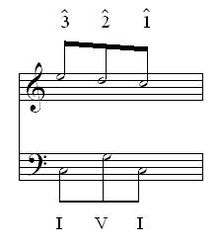Heinrich Schenker — (* 19. Juni 1868 in Wisniowczyk, Ukraine; † 13. Januar 1935 in Wien), österreichischer Musiktheoretiker und Komponist galizischer Herkunft. Inhaltsverzeichnis 1 Leben 2 Ursatz 3 … Deutsch Wikipedia
Reduktionsanalyse — Die Reduktionsanalyse ist ein von dem Wiener Musiktheoretiker Heinrich Schenker entdecktes System zur Analyse von tonaler Musik. Es beruht auf der Annahme, dass jedes Stück Musik nach einer Struktur aufgebaut ist. Mittels Reduktionsanalyse lässt… … Deutsch Wikipedia
Prolongation — In music theory, prolongation refers to the process in tonal music through which a pitch, interval, or consonant triad is able to govern spans of music when not physically sounding. It is a central principle in the music analytic methodology of… … Wikipedia
Fundamental structure — In Schenkerian analysis, the fundamental structure (German: Ursatz ) is a specific musical pattern that occurs at the most remote (or background ) level of structure. A basic elaboration of the tonic triad, it consists of the fundamental line… … Wikipedia
Harmonie (Musik) — Harmonik (von lat. griech. harmonia = „Zusammenfügung, Einklang“) ist ein umfassender Begriff aus der Musiktheorie und praxis; er steht für den Zusammenklang der Töne, also für die vertikale Komponente der Musik. In der Antike deckt sich die… … Deutsch Wikipedia
Harmonielehre — Harmonik (von lat. griech. harmonia = „Zusammenfügung, Einklang“) ist ein umfassender Begriff aus der Musiktheorie und praxis; er steht für den Zusammenklang der Töne, also für die vertikale Komponente der Musik. In der Antike deckt sich die… … Deutsch Wikipedia
SCHENKER, HEINRICH — (1868–1935), music theorist; the most important 20th century theorist of tonal music. Born in Wisniowczyki, Galicia. Schenker studied law as well as harmony with Bruckner in Vienna. After an early career as a composer, accompanist, editor, and… … Encyclopedia of Judaism
Hierarchy — A hierarchy (Greek: hierarchia (ἱεραρχία), from hierarches, leader of sacred rites ) is an arrangement of items (objects, names, values, categories, etc.) in which the items are represented as being above, below, or at the same level as one… … Wikipedia
Progressive tonality — is the name given to the compositional practice whereby a piece of music does not finish in the key in which it began, but instead progresses to an ending in a different key. To avoid misunderstanding, it should be stressed that in this… … Wikipedia
Satz (disambiguation) — Satz may refer to:* Satz, a formal section in music analysis * Satz (SAT solver), a well known SAT instance solverPeople with the surname Satz:* Alexander Satz (1941 2007), Russian pianist and educator * Ludwig Satz (1891 1944), Yiddish theatre… … Wikipedia

